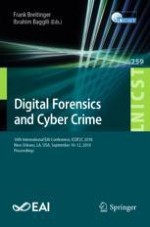2019 | OriginalPaper | Buchkapitel
Digital Forensic Readiness Framework for Ransomware Investigation
verfasst von : Avinash Singh, Adeyemi R. Ikuesan, Hein S. Venter
Erschienen in: Digital Forensics and Cyber Crime
Aktivieren Sie unsere intelligente Suche, um passende Fachinhalte oder Patente zu finden.
Wählen Sie Textabschnitte aus um mit Künstlicher Intelligenz passenden Patente zu finden. powered by
Markieren Sie Textabschnitte, um KI-gestützt weitere passende Inhalte zu finden. powered by
